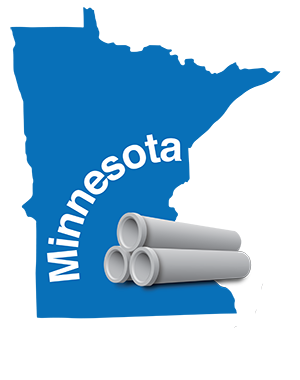
Pipe Strength Requirements
A pipeline is a system comprised of two components: (1) pipe material, and (2) bedding and compacted embedment material. This system performs two critical functions:
- It provides a conduit for stormwater and streamflow
- It provides a structure that’s sufficiently strong and durable to support construction equipment loads, soil (dead) loads, and traffic (live) loads for the intended design life of the project
Not All Pipe Materials Are Created Equal
Minnesota civil engineers and designers have two primary pipe material types at their disposal, each with its own unique structural design methodology:
- Concrete pipe is the only pipe material that meets the criteria for the rigid pipe design methodology
- Corrugated plastic pipe and metal pipe meet the criteria for the flexible pipe design
Similarities between rigid (concrete) and flexible pipelines
- All pipeline systems provide a conduit for stormwater and streamflow. Other than slight differences in roughness coefficient (“manning’s n”), concrete pipe and flexible pipe systems both provide a conduit.
Differences between rigid (concrete) and flexible pipelines
Reinforced concrete pipe (RCP) is by far the strongest pipe material, providing the primary structure for storm sewer and culvert installations. This primary structure is unique to concrete pipe. The inherent strength of concrete and steel reinforcement means that a concrete pipeline system relies a lot less on the strength of compacted embedment materials for its supporting strength.
Conversely, flexible pipelines (corrugated HDPE and polypropylene plastic pipe, metal pipe) get most of their strength from compacted granular embedment materials, with a relatively small amount of strength contributed by the flexible pipe material itself. This is especially true for plastic pipe. It’s an entirely different structural system than concrete pipe, requiring different design, installation and post-installation inspection procedures.
Structural Design Methods and Background Information
- Concrete Pipe
-
- MnDOT Technical Memorandum 20-05-B-01 “Reinforced Concrete Pipe Load Tables”
- file:///C:/Users/Jason%20Kruger/Downloads/TM1705B02-1846930-v2%20(2).PDF
- MnDOT Technical Memorandum 20-05-B-01 “Reinforced Concrete Pipe Load Tables”
-
- “PipePac” concrete pipeline design software
- Contact an MnCPA engineer for assistance (see contact link on this website)
- “PipePac” concrete pipeline design software
-
- In-depth engineering explanation of concrete pipe structural design
- ACPA Design Data 9: “Standard Installations and Bedding Factors for the Indirect Design Method“ https://www.concretepipe.org/wp-content/uploads/2014/09/DD_9.pdf
- In-depth engineering explanation of concrete pipe structural design
- Plastic Pipe (HDPE and Polypropylene):
-
- MnDOT Technical Memorandum 17-05-B-02 “Use of Plastic Pipe for Storm Sewer and Culverts on Trunk Highways”
- file:///C:/Users/Jason%20Kruger/Downloads/TM1705B02-1846930-v2%20(2).PDF
- MnDOT Technical Memorandum 17-05-B-02 “Use of Plastic Pipe for Storm Sewer and Culverts on Trunk Highways”

